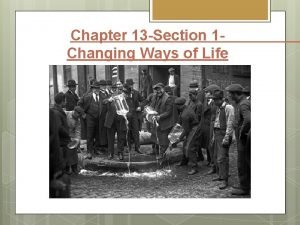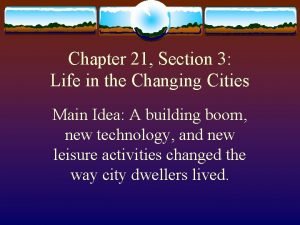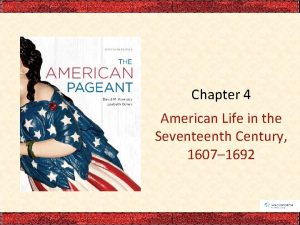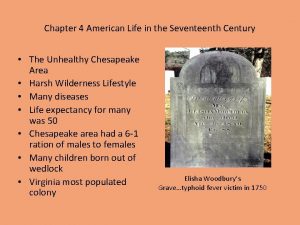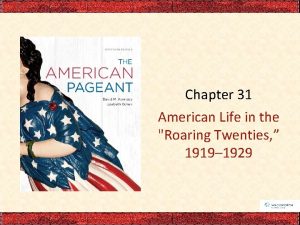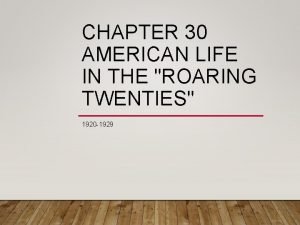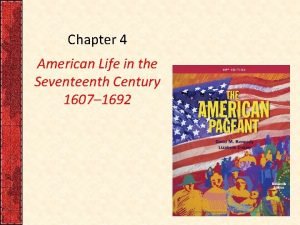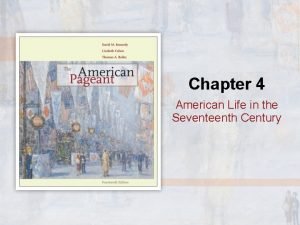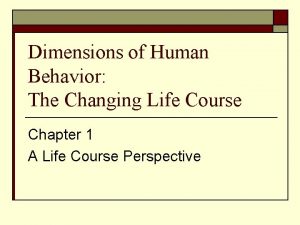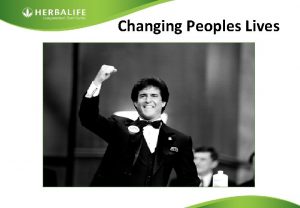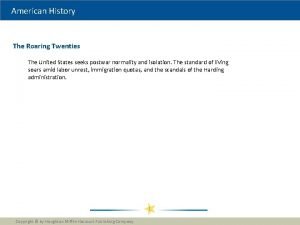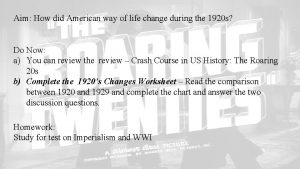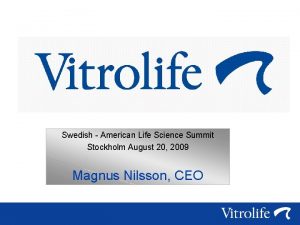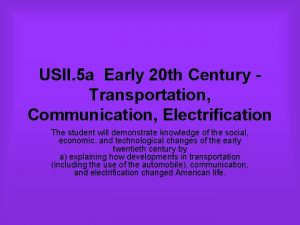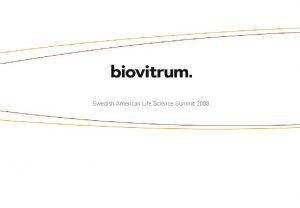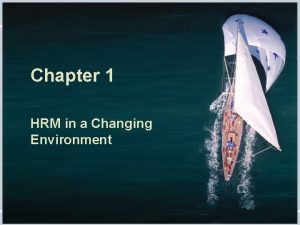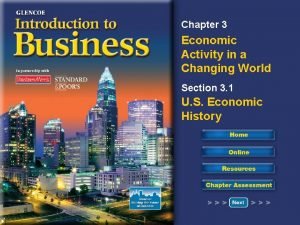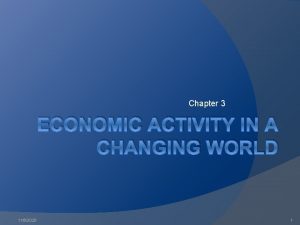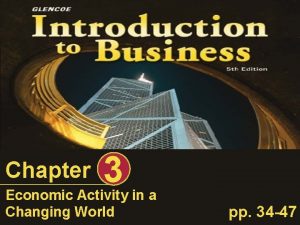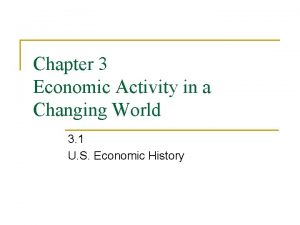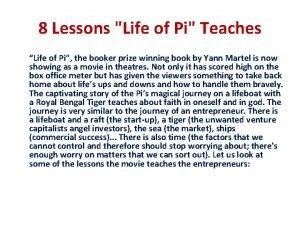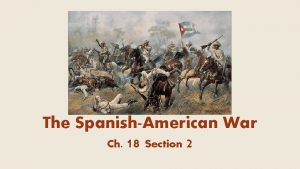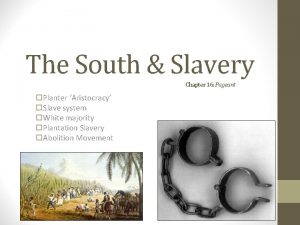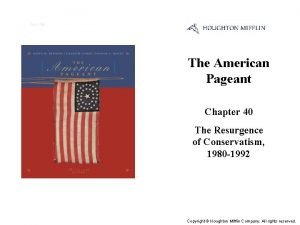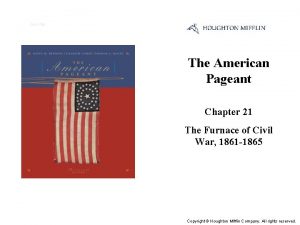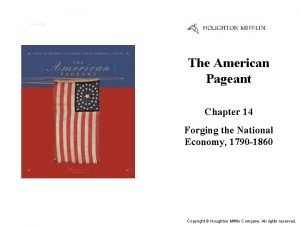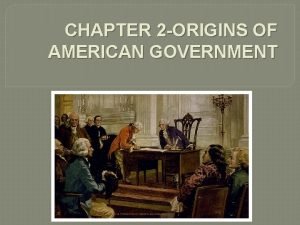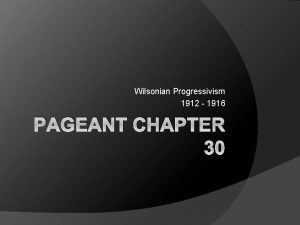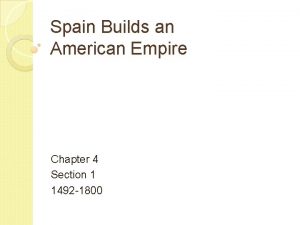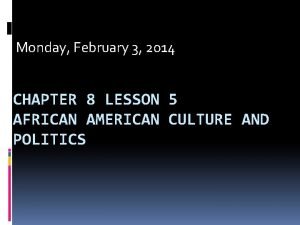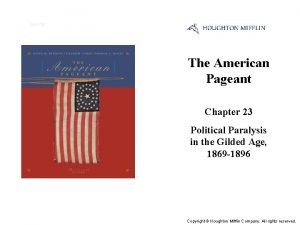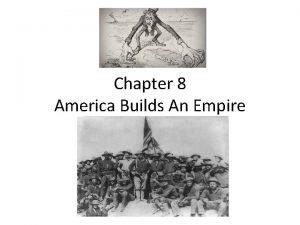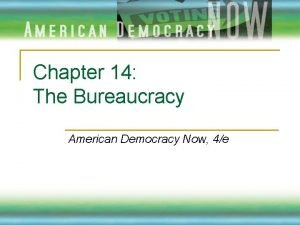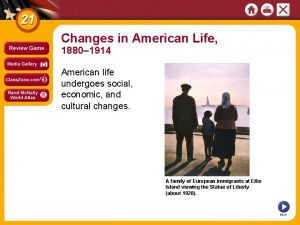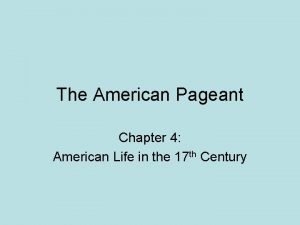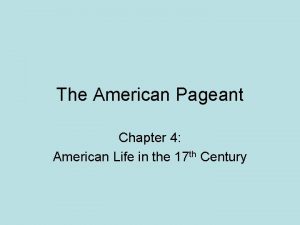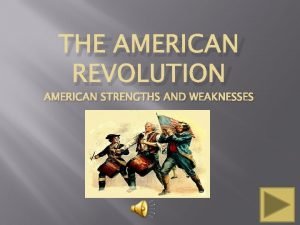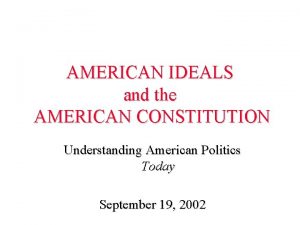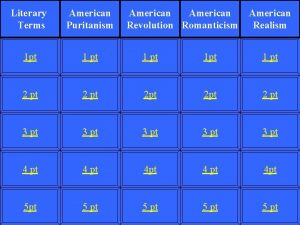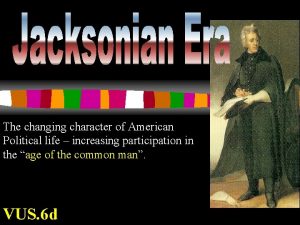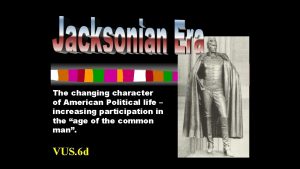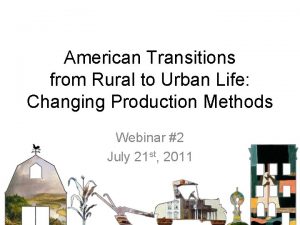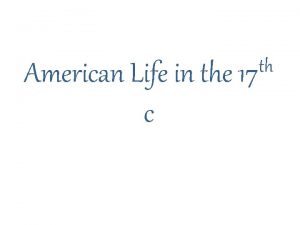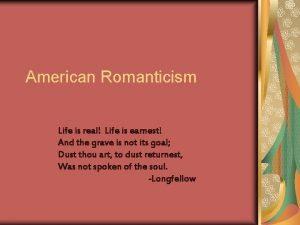CHAPTER 12 CHANGING AMERICAN LIFE Chapter 12 Changing
























































- Slides: 56

CHAPTER 12 CHANGING AMERICAN LIFE

Chapter 12 – Changing American Life pp. 212 -219 The key to American expansion in all areas of life was technology.

Chapter 12 – Changing American Life • The Great Wagon Road • ran north to south along the Appalachians pp. 212 -219

Chapter 12 – Changing American Life p. 212

Chapter 12 – Changing American Life pp. 212 -219 • The Wilderness Road • cut through the Appalachians via the Cumberland Gap • blazed by Daniel Boone

Chapter 12 – Changing American Life pp. 212 -219 • The National Road (Cumberland Road) • stretched from Baltimore to Vandalia, Illinois • first federally funded highway

Chapter 12 – Changing American Life pp. 212 -219 • Turnpikes • built by private companies who charged a toll to make a profit • Philadelphia-Lancaster Pike: nation’s longest pike

Chapter 12 – Changing American Life pp. 212 -219 • Early Waterways • difficult getting back upstream • boats often dismantled when they reached destination

Chapter 12 – Changing American Life pp. 212 -219 • Invention of the Steamboat • became a vital part of America’s transportation system • resulted in the growth of major cities along its routes (New Orleans, St. Louis, Cincinnati, Pittsburgh)

Chapter 12 – Changing American Life pp. 212 -219 • Robert Fulton: built the first commercially successful steamboat (the Clermont) • John Fitch: one of the earliest pioneers of the steamship

Chapter 12 – Changing American Life pp. 212 -219 • The Appearance of Canals • canal: shallow, manmade waterway connecting two bodies of water • locks: water compartments that can be opened and shut

Chapter 12 – Changing American Life p. 216

Chapter 12 – Changing American Life pp. 212 -219 • Erie Canal: the most famous canal • made New York the nation’s busiest port and most prosperous city

Chapter 12 – Changing American Life pp. 212 -219 • Early Railroads • John Stevens: built the first American locomotive • Peter Cooper: built the Tom Thumb

Chapter 12 – Changing American Life • Benefits of railroads • unaffected by terrain • faster and cheaper than canals • unaffected by weather pp. 212 -219

Chapter 12 – Changing American Life pp. 212 -219 • Results of railroads • became cheaper to ship goods • contributed to the Industrial Revolution • made America a “smaller” place

Chapter 12 – Changing American Life p. 219

Chapter 12 – Changing American Life • The Postal Service • 1639: first postal system in the colonies (established by Massachusetts Bay) • 1692: colonial postal system (established by the king) pp. 220 -221

Chapter 12 – Changing American Life pp. 220 -221 • Benjamin Franklin: became the first postmaster general of the United States • Samuel Osgood: became the first postmaster general under the Constitution

Chapter 12 – Changing American Life pp. 220 -221 • Pony Express: postal service running between St. Joseph, Missouri and Sacramento, California

Chapter 12 – Changing American Life pp. 220 -221 • The Telegraph • need: train stations needed to communicate with each other • Samuel Morse: invented the telegraph

Chapter 12 – Changing American Life pp. 221 -225 Industrial Revolution: advancements made in farming, manufacturing, and trade

Chapter 12 – Changing American Life pp. 221 -225 • Life in 1800 • Most Americans were subsistence farmers. • Tradesmen often specialized in one item that they would trade for food.

Chapter 12 – Changing American Life pp. 221 -225 • The Factory System • collected many workers in one place to produce a given product • began in England • Britain prohibited the export of machinery or the emigration of skilled workers

Chapter 12 – Changing American Life pp. 221 -225 • Samuel Slater’s Factory • had been an apprentice to the partner of the father of the English factory system • brought the secret of the English factory system to the United States

Chapter 12 – Changing American Life pp. 221 -225 • New England Industry • power supply (water power and steam power) • banking system (helped finance new industry)

Chapter 12 – Changing American Life pp. 221 -225 • Francis Cabot Lowell: organized a mill town for girls

Chapter 12 – Changing American Life pp. 221 -225 • The Sewing Machine • Walter Hunt: invented the first sewing machine • Elias Howe: first to patent the sewing machine

Chapter 12 – Changing American Life • Isaac Singer: patented a sewing machine with a foot pedal pp. 221 -225

Chapter 12 – Changing American Life pp. 221 -225 • Eli Whitney’s Influence • interchangeable parts • began producing gun parts in large quantities • led to mass production

Chapter 12 – Changing American Life • Results of the Rise of Industry • Positive • Negative • long hours, low wages • dangerous work conditions • growth of urban environments pp. 221 -225

Chapter 12 – Changing American Life pp. 221 -225 The rise of industrialism allowed for the growth of the middle class.

Chapter 12 – Changing American Life • Rise of Labor Unions • Mechanics’ Union of Trade Associations: first union pp. 221 -225

Chapter 12 – Changing American Life pp. 221 -225 • The Mechanics’ Free Press: newspaper designed to promote labor goals • free public education • debt reform • 10 -hour workday • end of child labor

Chapter 12 – Changing American Life pp. 221 -225 • results of labor unions: mixed success • economy and immigration affected the union’s success

Chapter 12 – Changing American Life pp. 226 -228 The technology that developed during this time period helped improve the farmer’s methods, lower his costs, and increase his profits.

Chapter 12 – Changing American Life pp. 226 -228 • Farming Before 1800 • used hand tools • crops were limited by the ability to plant and harvest

Chapter 12 – Changing American Life pp. 226 -228 The technological advancements in agriculture greatly increased crop yields, allowing fewer farmers to raise more crops.

Chapter 12 – Changing American Life pp. 226 -228 • John Deere’s Plow • made of high-grade steel • produced commercially • became important in conquering the prairies

Chapter 12 – Changing American Life • Cyrus Mc. Cormick’s Reaper • reaper: a machine that harvested grain pp. 226 -228

Chapter 12 – Changing American Life pp. 226 -228 • Eli Whitney’s Cotton Gin • cleaned short-staple cotton quickly and efficiently • caused cotton production to explode • created a greater need for slaves

Chapter 12 – Changing American Life pp. 228 -230 International trade expanded due to the increased production brought about by the advances in agriculture and industry.

Chapter 12 – Changing American Life pp. 228 -230 • New Asian Markets • Samuel Shaw and John Green • sailed the Empress of China with 30 tons of ginseng • Shaw opened America’s first trading company in Canton

Chapter 12 – Changing American Life pp. 228 -230 • Robert Gray • sailed around South America to China • first American to circumnavigate the earth

Chapter 12 – Changing American Life pp. 228 -230 • Commodore Matthew Perry: opened up trade with Japan (by force) in 1854

Chapter 12 – Changing American Life pp. 228 -230 The fishing industry (Grand Banks) and the whaling industry (Bering Sea) continued to grow during the 19 th century.

Chapter 12 – Changing American Life pp. 230 -236 • Immigration • The largest two groups of immigrants were the Germans and Irish. • Most Irish remained in the large, industrial cities in order to find factory work, but the living conditions were often poor.

Chapter 12 – Changing American Life pp. 230 -236 Immigrants made a lasting impact on the character of America.

Chapter 12 – Changing American Life pp. 230 -236 • Unitarianism • denied the doctrine of the Trinity • William Ellery Channing: most famous Unitarian

Chapter 12 – Changing American Life pp. 230 -236 • Transcendentalism • combined romantic ideals (an emphasis on emotion and intuition) with rationalism • Ralph Waldo Emerson and Henry David Thoreau: most famous transcendentalists

Chapter 12 – Changing American Life pp. 230 -236 The Second Great Awakening transformed the life of the church, and brought many to Christ.

Chapter 12 – Changing American Life pp. 230 -236 • The Second Great Awakening • Timothy Dwight: president of Yale • Asahel Nettleton: evangelist who insisted on calm, orderly services • Charles Finney: incorporated several “new measures” into his revivals

Chapter 12 – Changing American Life pp. 230 -236 • camp meetings • Cane Ridge, KY: site of the most famous camp meeting

Chapter 12 – Changing American Life pp. 230 -236 • Reform Movements • Education • Horace Mann: developed the first public high school

Chapter 12 – Changing American Life pp. 230 -236 • Abolition: fought to abolish slavery • the question of whether slavery was morally right or wrong became the central issue

Chapter 12 – Changing American Life pp. 230 -236 • Women’s Rights • Lucretia Mott and Elizabeth Cady Stanton: organized the Seneca Falls Convention to discuss women’s rights • sought the right to vote
 Chapter 13 section 1 changing ways of life
Chapter 13 section 1 changing ways of life Chapter 21 section 1 changing ways of life
Chapter 21 section 1 changing ways of life Chapter 4 american life in the seventeenth century
Chapter 4 american life in the seventeenth century Chapter 4 american life in the seventeenth century
Chapter 4 american life in the seventeenth century Chapter 31 american life in the roaring twenties
Chapter 31 american life in the roaring twenties Chapter 30 american life in the roaring twenties
Chapter 30 american life in the roaring twenties Chapter 4 american life in the seventeenth century
Chapter 4 american life in the seventeenth century Chapter 4 american life in the seventeenth century
Chapter 4 american life in the seventeenth century Life course perspective
Life course perspective Mark hughes herbalife
Mark hughes herbalife The roaring twenties lesson 3 changing ways of life
The roaring twenties lesson 3 changing ways of life Latin city model
Latin city model American way of life 1920
American way of life 1920 Swedish american life science summit
Swedish american life science summit Ways electrification changed american life
Ways electrification changed american life Swedish american life science summit
Swedish american life science summit Conceptual physics chapter 6 momentum
Conceptual physics chapter 6 momentum Chapter 1 hrm in a changing environment
Chapter 1 hrm in a changing environment Chapter 3 economic activity in a changing world answer key
Chapter 3 economic activity in a changing world answer key Chapter 3 economic activity in a changing world
Chapter 3 economic activity in a changing world Class 4 evs chapter 9 changing families
Class 4 evs chapter 9 changing families Chapter 3 economic activity in a changing world
Chapter 3 economic activity in a changing world Chapter 3 economic activity in a changing world
Chapter 3 economic activity in a changing world Vocabulary city life
Vocabulary city life City life vs country life
City life vs country life Algebraic expression real life example
Algebraic expression real life example Single life vs married life debate
Single life vs married life debate Difference between life skills and life orientation
Difference between life skills and life orientation Country life vs city life compare /contrast
Country life vs city life compare /contrast City life vs country life
City life vs country life Life of pi lesson learned
Life of pi lesson learned How do we treat the life the life how we treat
How do we treat the life the life how we treat The life that is truly life
The life that is truly life John needham experiment main idea
John needham experiment main idea Unit 8 country life and city life
Unit 8 country life and city life Valeriano butcher weyler
Valeriano butcher weyler American pageant chapter 16
American pageant chapter 16 The american dream in the great gatsby chapter 6
The american dream in the great gatsby chapter 6 Chapter 35 american pageant
Chapter 35 american pageant Latin american people win independence
Latin american people win independence Chapter 40 american pageant
Chapter 40 american pageant American pageant chapter 21
American pageant chapter 21 American pageant chapter 14
American pageant chapter 14 Chapter 2 american government
Chapter 2 american government American pageant chapter 13
American pageant chapter 13 The american pageant chapter 30
The american pageant chapter 30 Chapter 5 lesson 2 the spanish american war
Chapter 5 lesson 2 the spanish american war The great gatsby chapter 3 short summary
The great gatsby chapter 3 short summary The american revolution chapter 6 section 4
The american revolution chapter 6 section 4 Spain builds an empire
Spain builds an empire Chapter 8 lesson 5 african american culture and politics
Chapter 8 lesson 5 african american culture and politics The american pageant chapter 23
The american pageant chapter 23 Chapter 8 imperialism
Chapter 8 imperialism American democracy now chapter 14
American democracy now chapter 14 Guided reading activity lesson 3 new american diplomacy
Guided reading activity lesson 3 new american diplomacy Similarities between inca maya and aztec
Similarities between inca maya and aztec Chapter 10 section 2 the spanish american war answer key
Chapter 10 section 2 the spanish american war answer key
